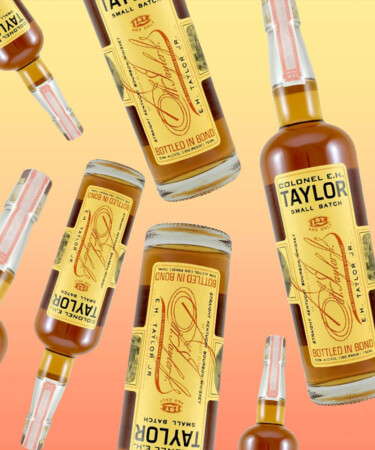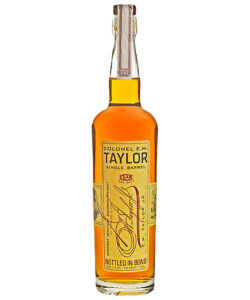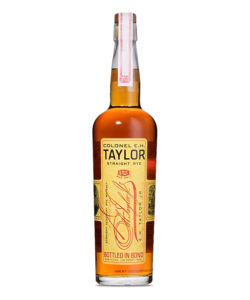Few figures loom as large in bourbon’s history as Colonel Edmund Haynes Taylor Jr, whose vision and relentless drive for crafting high-quality spirits led him to revolutionize both bourbon production and marketing. But behind the innovation, Taylor’s life as a whiskey tycoon was quite tumultuous. Amid a career in politics and scandalous business practices, the quality of Taylor’s bourbon never wavered.
Like most important characters in bourbon history, Taylor is today immortalized in a whiskey line that proudly bears his name. E.H. Taylor, Jr. (or EHT to whiskey geeks) is currently produced at the Buffalo Trace distillery using some of the very practices the late Colonel introduced.
Here are nine more things you need to know about E.H. Taylor, Jr. bourbon to better understand how Buffalo Trace, Taylor, and his namesake whiskey are all intertwined.
Colonel Taylor founded the distillery that later became Buffalo Trace.
Buffalo Trace is one of the longest continuously operating distilleries in the United States. Located on the banks of the Kentucky River in Frankfort, Ky., the site where Buffalo Trace now stands has a history of distillation dating back to 1775. The distillery as we know it today came into being in 1870, when Taylor purchased the site, upgraded the existing facility, and renamed it Old Fashioned Copper, or O.F.C. for short. Focusing on using high-quality copper equipment for distillation and rigorous cleaning regimens, Taylor’s bourbon became a favorite among whiskey lovers from all over.
E.H. Taylor, Jr. shares a recipe with famous siblings.
Buffalo Trace uses a few different recipes to craft its various whiskey brands. Known as mash bills, these recipes use different proportions of “flavoring” grains rye and wheat to achieve different flavor profiles. E.H. Taylor, Jr. is made using Buffalo Trace’s mash bill #1, which is believed to be a low-rye recipe that is also used to make Buffalo Trace, Eagle Rare, and the top shelf George T. Stagg.
The E.H. Taylor, Jr. line includes multiple types of whiskey.
The full line of E.H. Taylor, Jr. whiskeys contains 12 whiskeys, spanning both regular and one-off limited releases. Beyond the flagship bottled-in-bond small-batch bourbon, there are also single-barrel and barrel-proof expressions as well as a rye whiskey. Over the years, Buffalo Trace has also released some more experimental bourbons under the E.H. Taylor, Jr. banner, including the E.H. Taylor, Jr. Warehouse C Tornado Surviving, which was blended from barrels that made it through a tornado-damaged warehouse unscathed.
Taylor built a medieval-style castle in Kentucky — and distilled bourbon in it.
After a series of poor business decisions, Taylor eventually had to sell his O.F.C. distillery to George T. Stagg, a Civil War hero and investor from St. Louis, who is also honored with his own line of barrel-proof bourbon. Taylor was still involved with production, and his name and image were still used for branding, but due to many disagreements, Taylor and Stagg parted ways. Taylor was in no way finished with the bourbon industry, however. He built a new distillery just south of Frankfort called the Old Taylor Distillery, which was built to resemble a European castle. This facility operated under Taylor’s supervision until his death in 1923 when it was passed on to his sons. Eventually, they sold both the distillery and the E.H. Taylor, Jr. brand, and after passing between National Distilling and Jim Beam’s ownership, the Old Taylor distillery was finally abandoned in 1972.
Good luck finding some E.H. Taylor, Jr.
Like many other whiskies produced by Buffalo Trace, the demand for E.H. Taylor, Jr. far outweighs the supply. Because of this, the bottle is allocated, meaning each liquor store, bar, or restaurant can only purchase a limited number of bottles each time it’s released. Bottles tend to fly off the shelves when available, and the more limited expressions can sometimes cost thousands of dollars on the secondary market.
E.H. Taylor, Jr. is bottled in bond, honoring its founder.
Passed in 1897, the Bottled in Bond Act was a legal framework that protected both whiskey distillers and drinkers from a flood of adulterated, counterfeit whiskey. The label “bottled in bond” serves a stamp of quality — the whiskey must be aged for at least four years in a federally bonded warehouse, produced within one distilling season, and bottled at 100 proof (50 percent ABV). Colonel Taylor played an important role in lobbying for the law’s passage, so many of the whiskeys in his eponymous line are bottled in bond as an homage.
The distillery still uses one of Taylor’s original warehouses today.
Built in 1881 under Taylor’s supervision, Warehouse C is still used by Buffalo Trace as a rickhouse for aging barrels of whiskey. There is even a special limited-release bottling of E.H. Taylor that’s blended entirely from barrels taken from the second and fifth floors of Warehouse C.
E.H. Taylor, Jr. finally came home in 2009.
After the Old Taylor distillery was sold, both the facility and the brand changed hands between companies for decades. Bourbon emblazoned with Taylor’s name and likeness continued to be produced, but not always in the Frankfort distilleries that he helped to found. In 2009, the Old Taylor brand was purchased from Jim Beam by Buffalo Trace, and in 2013 the modern iteration E.H. Taylor, Jr. bourbon hit the market.
The current label design is based on the original bottle from the 1800s.
When Buffalo Trace revived the E.H. Taylor, Jr. brand, the company based the bottle design on the one used by the Old Taylor distillery a century ago. The focal point of the label is Colonel Taylor’s ornate signature, and the back of the bottle honors his legacy as the “founding father” of the modern bourbon industry. Each bottle also arrives in a cardboard canister, which was also inspired by the one used at the turn of the century.


